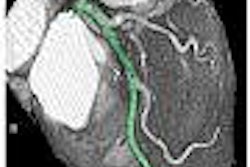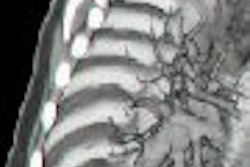SAN FRANCISCO - The speedy evolution of CT technology in recent years might lead one to believe that the modality has finally arrived. And it has, if one considers the vast improvement that today's multislice technology represents over the single-detector-row scanners of the early 1990s, a time when pathologies were spotted in the grainy 2D shadows that presaged today's exquisitely detailed images.
But the engineers and medical physicists who specialize in CT like to focus, naturally, on what they haven't yet achieved. One of them, CT pioneer Willi Kalender, Ph.D., from the University of Erlangen-Nürnberg in Germany, held up the metaphorical half-empty glass in a presentation Wednesday at the International Symposium on Multidetector-Row CT, listing the top five most important things CT "needs but doesn't have yet." Doubling the detector rows didn't even make the list.
"When talking about things we really need, the danger is that we talk about it in ways that are technology-driven -- that would be to double the slices again and again -- but I don't think that's the way," he said. "We have to think of what is really needed clinically."
Clinically, radiologists need shorter effective scan times for reliable cardiac imaging, for example, and larger z-axis coverage for perfusion and other functional measurements (for brain, heart, and lung imaging, particularly). To accomplish this, effective scan times must be trimmed to less than 50 msec, down from the 330 msec currently available. How to accomplish this? The first two items on the wish list might do.
- A system with multiple sources and detectors for higher peak x-ray power and shorter scan times
- A system with multiple detectors or a segmented detector for higher spatial resolution and for fluoroscopy/radiography
"It's always good to look at the constraints," Kalender said.
For example, the rotating equipment in the gantry is subject to centrifugal forces that increase at a faster rate than the rotation speeds. "And if you go faster and faster, then the x-ray power has to be increased exactly by the inverse of the rotation time," he said. "We have to go slower to get the necessary x-ray power. So if we go from 330 msec where we are right now to 150 ms we would have to double it."
Moreover, the most powerful x-ray sources in today's scanners produce 80-100 kw, and it wouldn't be easy to increase that specification, either from the viewpoint of design or the hospital power lines needed to feed it, he said.
The idea of multiple x-ray sources and detector arrays isn't new; like other ideas on Kalendar's list, it was actually conceived in the late 1970s, CT's most innovative period, he said. A dual-source scanner was even offered as an option in the 1980s, he said, though the technology to support it was completely inadequate. Still, researchers were able to depict some pathologies better with the use of two x-ray sources, he said, offering a dual-source head CT image from the archives.
Another old idea that could be ripe for resurrection is the configuration of two overlapping detector arrays in a cross or "t-shirt" design, Kalender said. The area where the two arrays crossed would yield twice the resolution as the nonoverlapping parts.
"Why that intrigues me is if you had such a system you could do other things," he said. For example, the detector arrays could be configured differently, one spaced evenly, the other bunched closer together towards the center of the array. This leads to the next two items on his wish list:
- Interactively variable isotropic spatial resolution
- More tissue parameters (escape the Hounsfield unit cage)
With such overlapping arrays of detectors in place, one could think about creating new kinds of detectors that pick up different spectra, providing new ways of examining tissue properties and escaping the "Hounsfield unit cage" that CT has always been tied to, he said.
As for interactively variable resolution, it's clear that CT needs new ways of looking at data, Kalender said.
"We're really stuck there," he said. "It's both the slice width and the reconstruction kernel you're familiar with. You have two different tasks, the lung and mediastinum, and you have to do completely different reconstructions. And that means two stacks of 500 images or whatever."
It would be far simpler to store only the raw data, and view it precisely as needed for the task at hand, he said. Yet this solution, however technologically feasible, could be complicated by the tendency of vendors to hold their reconstruction algorithms close to the vest.
"The resolution changes are 3D convolution -- so you would have the same results if you did different reconstructions with different slice thicknesses and different resolutions," Kalender said. "This is also making sure that it's isotropic resolution."
And the final item on Kalendar's wish list:
- Establishment of CT as a low-dose modality
This isn't a technological challenge, but rather a matter of spreading the word, according to Kalender.
"CT is a low-dose imaging modality -- everyone is aware of that at last, and should be," he said. "We have automatic exposure control, and we can spread the news now: CT is a low-dose modality."
By Eric Barnes
AuntMinnie.com staff writer
June 16, 2005
Related Reading
International committee of CT users and vendors settles on mass as the standard measurement of coronary calcium, December 2, 2003CT pioneer sees bright future for the technology, June 27, 2003
Copyright © 2005 AuntMinnie.com




















